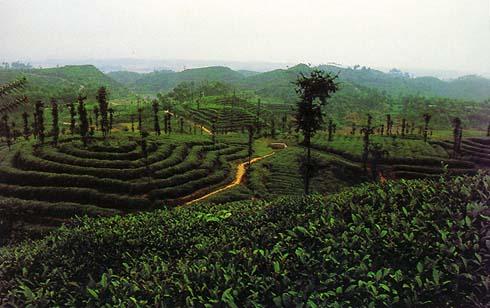Photos by: Editorial department
Driving to the southeastern Menghai County town of Menghun, one of Menghai's six famous tea mountains leapt into view: Hekai Mountain. It belongs to the southern extension of the Nujiang mountain range and occupies a total area of 150 square kilometers. It connects with Pasha Mountain to the East, Bulang Mountain to the Souths and Nannuo Mountain to the North. It lies at an altitude between 1400 and 1700 meters. This stretch of nearly 10,000 mu (1 mu = 1/6 acre) of interconnected ancient tea growing areas is one of the best preserved and largest ancient tea mountains in Xishuangbanna.
Tea trees large and small grow one after the other, each with its own unique form. The tea growing area encompasses seven villages including: Manmai, Mannan, the old and new villages of Mannong, Bangpen old town, and Guangbie old town. Among these, the Guangbie old town tea growing areas attract the most attention.
Continuing deeper into the mountains, the smooth paved road gradually became a bumpy dirt road. After passing through the Guangbie new village, the new Guangbie old village, and stretches of newly cultivated tea plantations, we arrived at Guangbie old village. This location is the former site of the village, and today it contains no houses. All that is left is a decaying bamboo fence, a few small thatched work huts, and leftover inlaid stone foundations. Most of the ground has already been transformed into fields. Walking further up the mountainside from there, a large and impressive ancient tea garden came into view. It seemed to extend a warm welcome to visitors.
Under the jurisdiction of the Manbang village committee, Guangbie old village is located in the deep mountains of the Hekai ancient tea mountain area. In the past, local living conditions were very primitive. Life was extremely difficult. Transportation was inconvenient,and food and shelter were often lacking. Facilities of all sorts were quite backwards, with modernization occurring only very slowly. The feverish pursuit of ancient arbor Puerh tea by Taiwan, Hong Kong, and Mainland China,however, presented a critical opportunity for these pristine ancient arbor tea gardens.
In 2005, the Chinese government established the Guangbie old village as a poverty assistance relocation test village and moved it two kilometers from its old location. Receiving construction assistance from the New Rural Development Initiative and other programs, this old village began to experience relatively modern development. Concrete roads showed up, and cars appeared in the village. Food was available in abundance. The smiles on the faces of the villagers also appeared to brighten. Today the village contains approximately 80 households and over 300 residents. Aside from growing sugarcane, tea constitutes the most important economic activity of local residents. This includes household tea, new tea gardens more than 50 years old, ancient tea gardens more than 300 years old, and even ancient garden over 1000 years old.
According to Mr. Bao Zhuo, who first arrived at the old location of the Guangbie old village in 2003, locals did not know the value of their tea trees. Because one jin (1/2 kg) was only worth 2 or 3RMB ($0.25-$0.35US), in the past they cut down tea trees to grow corn. Yearly income was nonetheless still quite low—at most 200RMB (~$25US). The ancient tea growing areas of Guangbie old village came very close to being abandoned. Thankfully, Taiwanese tea businessman Liao Yijun signed an agreement with the villagers to manage tea harvest and processing. He worked carefully and patiently to protect and manage the tea trees. This included removing parasitic plants, using natural organic fertilizer, straightening trees growing at an angle, and trimming withered or diseased branches and leaves. Liao Yijun's passion for the ancient tea gardens deeply moved Bao Zhuo. A production and sale contract with Mr. Liao that followed has helped to spread the reputation of the Guangbie old village ancient tea gardens throughout the Puerh tea market.
The 1000 year old tea garden located at the former site of the Guangbie old village covers an area of approximately 200 mu. Its trees are not inferior to the ancient tea trees of Jingmai. The tea garden grows on a slight incline. It contains a thick and soft layer of humus and ideal climate and other soil conditions. Only at this very late stage has it been developed, and each of the tea trees is extremely robust and flourishing. We brewed a cup of transparent, honey-yellow tea using fresh tea from Guangbie old village by a Chinese style tea cup. A gentle and elegant aroma emanated from the tea, creating a burst of freshness. As the tea enters the mouth, a warm and fragrant flavor strokes every cell in the mouth. This is Guangbie old village tea's greatest characteristic: even if it is a bit bitter, the huigan comes quickly. It is somewhat astringent, but its ability to promote saliva is extraordinary. The key is its mellow and pleasant sweetness. It is able to penetrate to the bottom of the tongue and into the tongue, leaving the entire mouth feeling moist. It passes smoothly through the throat and feels warm and gentle in the stomach. It causes tea drinkers to thoroughly experience the satisfaction and pleasure of drinking tea and its quality and value are no less than that of Banzhang tea.
Puerh tea's explosive growth has brought the advantages of economic development to all ancient tea growing areas of Yunnan. This rebirth of the Guangbie old village can also serve as an example to increase the quality of life for numerous other poor villages. Today the quality of life and the environment in many villages have benefited from this construction and development.
Although the passing of the Puerh storm of 2007 has caused Guangbie old village tea prices to fall somewhat, they are still far higher than 2003 prices. I believe that as long as they persist in producing high-quality tea these farmers will continue to enjoy healthy incomes in the future.



